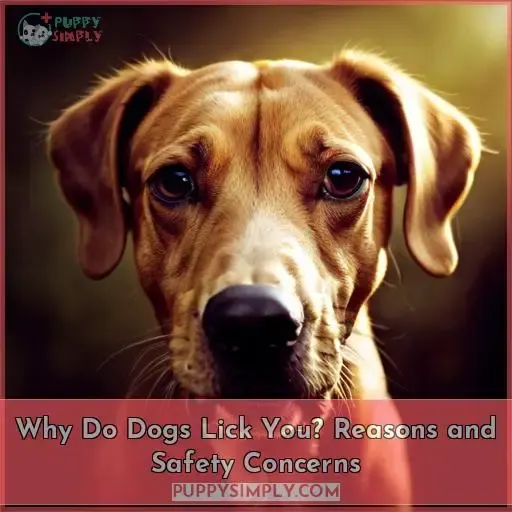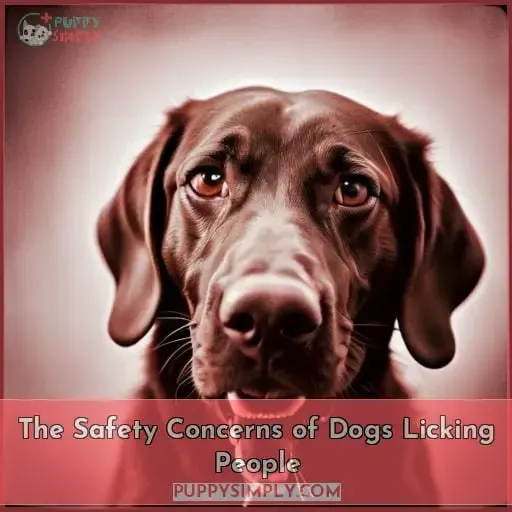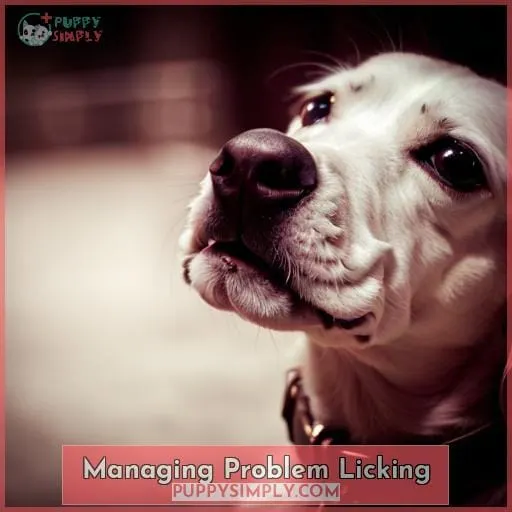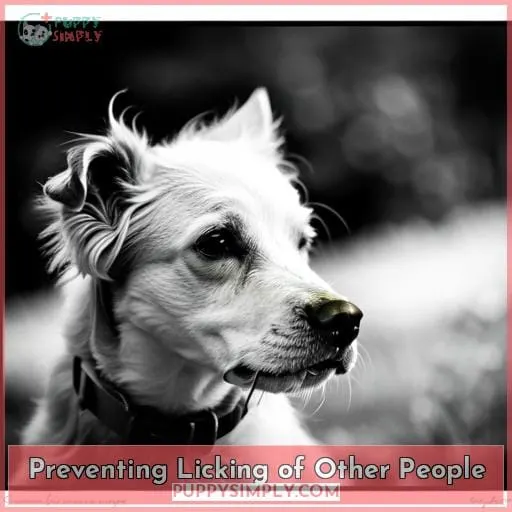This site is supported by our readers. We may earn a commission, at no cost to you, if you purchase through links.
 Curious why your furry friend can’t resist showering you with slobbery kisses? Dogs licking humans is a common behavior that serves multiple purposes. While it may seem like an affectionate gesture, there’s more to it than meets the eye.
Curious why your furry friend can’t resist showering you with slobbery kisses? Dogs licking humans is a common behavior that serves multiple purposes. While it may seem like an affectionate gesture, there’s more to it than meets the eye.
From seeking attention to exploring their environment and even mimicking maternal instincts, dogs have various reasons for licking you.
In this article, we’ll delve into the fascinating world of doggy licks and explore both the reasons behind them and potential safety concerns.
Table Of Contents
- Key Takeaways
- Reasons Dogs Lick People
- The Safety Concerns of Dogs Licking People
- Managing Problem Licking
- Preventing Licking of Other People
- Frequently Asked Questions (FAQs)
- Can dogs develop allergies or sensitivities to certain substances that they lick off of people?
- How can excessive licking be distinguished from normal grooming behavior?
- Are certain dog breeds more prone to excessive licking than others?
- Can excessive licking be a sign of a more serious underlying medical condition?
- Are there any training techniques or strategies that can help discourage dogs from licking people?
- Conclusion
Key Takeaways
- Dogs lick people as a learned behavior from puppyhood, as a way to seek attention and affection, and as an instinctual behavior from their wild canid ancestors.
- Licking releases dopamine in dogs, promoting relaxation and happiness, and can be a way for them to show emotional understanding and attempt to comfort their owners.
- It is important for dog owners to establish comfortable boundaries with their pets when it comes to licking and to address any underlying issues if excessive licking occurs.
- Understanding the reasons behind a dog’s licking behavior, such as loneliness or boredom, can help redirect their behavior to more appropriate activities and prevent potential safety concerns.
Reasons Dogs Lick People
Dogs lick people for a variety of reasons.
One common motive is affectionate behavior, as dogs learn licking from grooming and affection during puppyhood.
Seeking attention is another reason, with dogs using licking to get their owners’ attention and often receiving positive reactions in return.
Instinctual behavior rooted in wild canid pack interactions also plays a role, as does taste exploration when dogs are intrigued by interesting flavors on human skin.
However, problematic licking may indicate underlying issues such as anxiety or obsessive-compulsive disorder and should be addressed accordingly.
Affectionate Behavior
Dogs lick you as a sign of affection. This behavior is influenced by their experiences during puppyhood, where they learn grooming and bonding through licking.
Licking releases dopamine in dogs, promoting relaxation and happiness.
It also shows emotional understanding as dogs may attempt to comfort or care for their owners by licking them when they’re distressed.
However, it’s important to establish comfortable boundaries to ensure that both you and your dog feel secure in this form of canine communication.
Seeking Attention
When seeking attention, dogs use licking as a way to engage with their owners and elicit a response. It’s one of their go-to techniques for getting your undivided focus. By showering you with slobbery kisses, they hope to capture your attention and affection.
This behavior can be influenced by loneliness or boredom, where licking serves as both a behavioral distraction and an attempt to fill the void in their lives. Positive reinforcement is key in redirecting this behavior while respecting personal space boundaries.
Instinctual Behavior
Your dog’s instinctual behavior, specifically their inclination to lick you, is deeply rooted in their genetic makeup.
With wild origins and a keen sense of smell, dogs have evolved to use licking as a form of communication and bonding. From maternal bonding to taste preferences, licking serves various purposes for dogs.
Understanding these instincts can help address excessive or problematic licking through behavioral solutions and safety measures such as using interactive toys like licking mats.
Taste Exploration
One of the reasons dogs lick you is to explore the taste of your skin and discover interesting flavors through their sense of taste.
Dogs have unique flavor preferences, influenced by their canine taste buds, which allow them to detect different tastes with a high level of sensitivity.
They may be particularly drawn to salty skin as it offers a distinct and enticing flavor experience for them.
Their licking behaviors serve as a way for dogs to satisfy their curiosity about the world around them.
Problematic Licking
If your dog excessively licks you or others, it may indicate underlying issues such as:
- Anxiety
- Health problems
- Allergies
- Injuries
- Arthritis
Problematic licking can be a sign of compulsive disorders and medical issues that require attention. Behavioral solutions like redirecting the behavior to positive outlets such as lick mats can help manage excessive licking.
It’s important to consult with a veterinarian for proper evaluation and treatment options to promote holistic well-being for your furry friend.
The Safety Concerns of Dogs Licking People
When it comes to dogs licking people, there are a few safety concerns that should be considered.
First, the myth of clean mouths should be debunked – while dogs do have natural bacteria in their mouths, it can pose a risk if it enters open wounds.
Second, there’s the potential for dog bites which can be dangerous due to the bacteria present in their mouths.
While harmful effects are unlikely unless there are open wounds involved, regular vet appointments and teeth cleanings are advisable for overall safety.
Myth of Clean Mouths
Now let’s delve into the safety concerns surrounding dogs licking people, starting with debunking the myth of clean mouths.
Contrary to popular belief, dogs’ mouths aren’t cleaner than humans’. They contain a variety of oral bacteria that can pose a risk if they enter open wounds. Comparative studies on canine hygiene have revealed that dogs have different types and levels of oral bacteria compared to humans.
It’s important to be aware of this reality and take appropriate precautions when allowing your dog to lick you or others.
Risk of Dog Bites
When dogs lick people, there’s a potential risk of dog bites due to the bacteria present in their mouths.
Understanding bacteria and preventive measures can help mitigate this risk.
Behavioral triggers that may lead to biting should be recognized, while human reactions should prioritize safety.
Veterinary guidance is essential in addressing behavioral issues and providing appropriate advice on how to prevent licking and minimize the risk of dog bites.
- Veterinary guidance
- Preventive measures
- Behavioral triggers
- Human reactions
Managing Problem Licking
Now let’s explore some strategies for managing problem licking in dogs.
When your dog engages in excessive licking, one approach is to deny attention by ceasing any interaction or eye contact during the behavior. This helps discourage the behavior as dogs often seek attention through licking.
Additionally, positive reinforcement can be effective by rewarding your dog with attention, affection, or treats when they stop licking and redirecting their focus to more appropriate activities like chew toys or training exercises.
Denying Attention
To manage problem licking, you can deny attention when your dog starts to lick you.
By withdrawing your touch and gaze, you communicate that this behavior isn’t desired.
Turning away or walking away if necessary can further reinforce the boundary setting.
Redirecting their focus onto other activities through training techniques or using a distraction method like chew toys can also be effective in addressing this behavior.
Consistency and clear communication signals are key in teaching them how to stop excessive licking.
Positive Reinforcement
Reward your dog with attention, affection, or treats when they stop excessive licking.
By using training techniques that focus on behavioral rewards and encouraging desired behavior, you can effectively discourage excessive licking.
Consider incorporating interactive puzzles or trick training as incentive practices to redirect their attention and provide mental stimulation.
Remember to use calming signals to communicate your expectations during the reinforcement process.
Preventing Licking of Other People
Now that you understand how to manage problem licking, let’s move on to the topic of preventing dogs from licking other people. It’s important to establish behavior boundaries and social etiquette for your canine companion.
- Set Clear Boundaries:
- Teach your dog not to lick certain body parts, such as the face or hands.
- Use verbal cues like No lick or Off when they attempt to lick.
- Redirect their Attention:
- Offer appropriate alternatives like chew toys or interactive puzzles when guests arrive.
- Distract them with treats during greetings, rewarding calm behavior instead of jumping up.
- Maintain Personal Hygiene:
- Regularly clean yourself after exercising or sweating heavily.
- Keep a towel nearby so you can wipe off any excess sweat before interacting with your dog.
- Seek Professional Help if Needed:
If your dog continues compulsive behaviors despite training efforts, consult a veterinary behaviorist for further guidance and assistance in managing this issue effectively.
By implementing these strategies, you can ensure good canine manners while maintaining healthy social interactions between your furry friend and others around them.
Frequently Asked Questions (FAQs)
Can dogs develop allergies or sensitivities to certain substances that they lick off of people?
Yes, dogs can develop allergies or sensitivities to substances they lick off of people. It’s important to be aware of any potential irritants and consult a veterinarian if you notice signs of an allergic reaction in your dog.
How can excessive licking be distinguished from normal grooming behavior?
Excessive licking can be distinguished from normal grooming by its frequency, duration, and intensity.
If your dog obsessively licks to the point of causing injury or neglecting other activities, it may indicate an underlying issue that requires professional evaluation.
Are certain dog breeds more prone to excessive licking than others?
Certain dog breeds may exhibit a higher tendency for excessive licking, but it isn’t exclusive to any specific breed. Factors such as individual temperament and environmental influences play significant roles in determining this behavior.
Can excessive licking be a sign of a more serious underlying medical condition?
Excessive licking can be a red flag for underlying medical conditions. Like an alarm bell in the night, it signals discomfort or distress.
Consult your veterinarian to ensure your furry friend is healthy and happy.
Are there any training techniques or strategies that can help discourage dogs from licking people?
To discourage dogs from excessive licking, training techniques such as:
- Redirecting their attention to alternative activities
- Rewarding desired behaviors
can be effective.
Consistency and positive reinforcement are key in modifying this behavior.
Conclusion
In summary, dogs lick humans for various reasons including:
- Affection
- Seeking attention
- Exploring their environment
It’s important to understand that while dogs’ licking behavior may seem endearing, there are potential safety concerns associated with it.
- Contrary to popular belief, dogs’ mouths aren’t necessarily clean, and there’s a risk of dog bites.
- Managing problem licking involves denying attention and using positive reinforcement.
- Additionally, it’s crucial to prevent dogs from licking other people to ensure everyone’s safety and comfort.
So, next time your furry friend showers you with slobbery kisses, remember the reasons behind their behavior and take necessary precautions.










